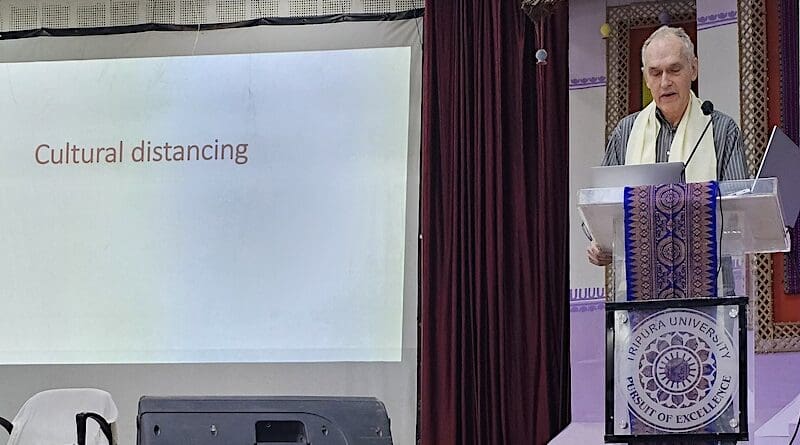Van Schendel: Spirit Of 1971 Never Quite Returned To Bangladesh After 1975 – Interview
Europe’s leading scholar on South Asian borderlands Willem Van Schendel discussed in depth a host of issues with Subir Bhaumik on the sidelines of a recent seminar on “Ethnicity, Security & Development“ hosted by Tripura University’s Political Science Department in state capital Agartala. Excerpts of the Conversation are below:
Q: What kind of future you see for Bangladesh?
A: Increasingly, the democratic process stands compromised. It is internationally recognised that the last three elections (2014, 2018, 2024) were rigged to ensure the Awami League’s continuation in power. What is especially concerning is that critical voices are increasingly being silenced. The high ideals that inspired the Awami League after the Liberation War of 1971 are very difficult to discern today. Bangladesh civil society and the culture of free debate are in dire need of being revitalised.
Q: Do you think Islamisation is on the rise in Bangladesh?.
A: I don’t think most Bangladeshis are intolerant, but the state and the political system have been embracing religious organisations and parties for short-term political gain. Linking state power and religion is always a very dangerous strategy. This is especially true in Bangladesh, not only because this state started out with a pledge to secularism, but also because of the long-term history of identities in this region. Bengali culture has deep roots and for centuries it has comfortably coexisted with the practice of Islam. Muslim Bengalis have always insisted on graciously balancing their ethnic and religious identities, sometimes foregrounding their Bengaliness and sometimes their Muslimness. Throughout the 19th and 20th centuries, attempts to give precedence to the Islamic identity (for example, through “purification movements”) have never had more than a temporary effect. This was very clear during the Pakistan period (1947-1971) when Bengalis soon became disillusioned with the state’s political manipulation of Islam. This may happen again.
Q: What do you think about the future of minorities and that of Chittagong Hill Tracts because there are indications that the government may do away with 1900 CHT manual which gives the minority-dominant region its special character ?
A: The 1900 CHT manual has already been undermined in spirit and practice, not least by some provisions of the 1997 CHT Peace Accord between the Government and the PCJSS- Shanti Bahini. The demographic character of the Chittagong Hill Tracts has changed due to large-scale immigration of Bengali settlers since the 1980s. So there is understandably much anger and apprehension among the local non-Bengali population, which consists of many different ethnic groups. They resent being seen as a security problem. The militarisation of the Chittagong Hill Tracts since the 1970s, and the many reports on challenges to human rights, point to a bleak future, unless the framing of the Chittagong Hill Tracts in terms of security threats (always vaguely defined) is changed. It is hard to maintain that that there is any credible security threat from either Myanmar or India in the Chittagong Hill Tracts. What is needed is a far more positive and constructive policy approach to this region. Such a policy is also needed for the many minorities who live outside the Chittagong Hill Tracts and who demand constitutional recognition.
Q: OK, do you think the military offensive by the ethnic rebel armies can dislodge the Burmese military junta?
A: Although in recent months the rebels have captured a lot of territory and inflicted stunning military defeats on the Tatmadaw (Burmese army) – which has serious leadership problems and internal divisions over the chief’s ability to handle the present crisis – it is far too early to say that the junta is on the way out. The alliance of insurgent groups is still fragile, and only speedy and continuous victories can keep it going. What is a very remarkable development, however, is the involvement of important Bamar (ethnic Burman) groups in armed resistance, which has not happened before. That takes the battle to the Bamar heartland instead of restricting it to the minority regions on Myanmar’s borders.
Q: How about the impact of the fighting on the borders?
A: I was on the China-Myanmar border not so long ago. The fighting has left the Chinese authorities worried. Significantly, the rebels have overrun many border outposts which were involved in border trade and they have eliminated scam centres targeting Chinese citizens. The advances of the Arakan Army in Rakhine and Chin States have been especially notable, leading to Burmese soldiers fleeing across the border to India and Bangladesh. But the military junta still has access to a lot of resources that it can export: timber, jade, gems, fish, gas, etc. The military hardware possessed by the junta is superior to that of the many rebel armies, so the Tatmadaw is ahead in firepower – but there are indications that the morale of the troops is slipping.
Q: What is the larger take from the Myanmar crisis?
A: Brute military force has been an instrument of control in Myanmar right from its shaky beginnings in 1948. This has led to armed responses by many minorities. Imposing a military solution on these internal wars has proved to be impossible. This is a lesson for India and Bangladesh as well. Ethnic aspirations to full citizenship, cultural plurality, and regional autonomy cannot be permanently put down by brute force. On the contrary, choosing this policy will only exacerbate these conflicts in the long run, as the Myanmar case has shown.

